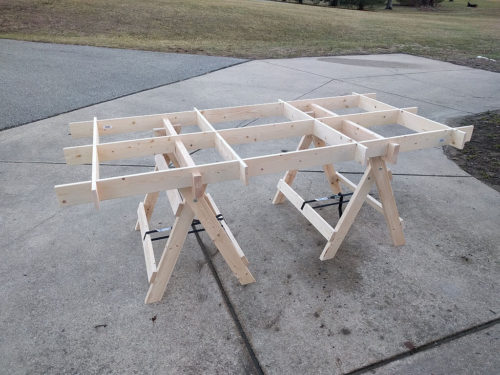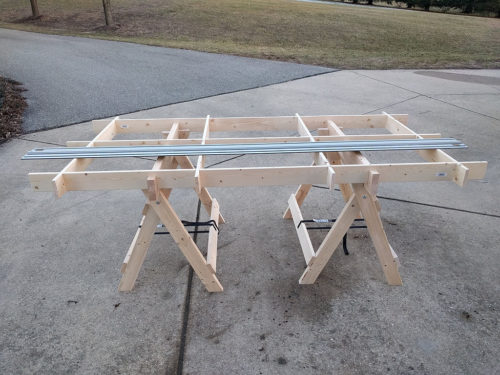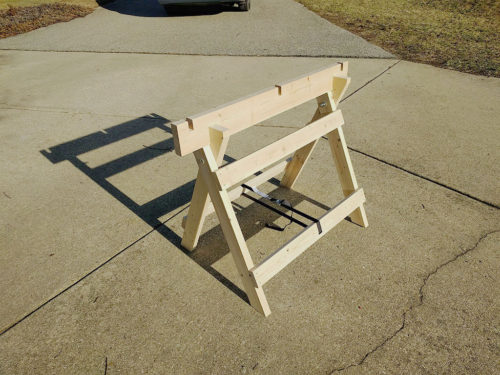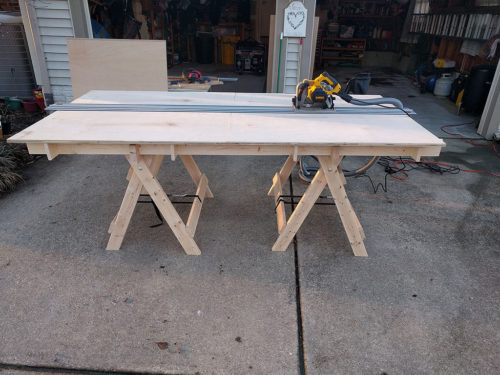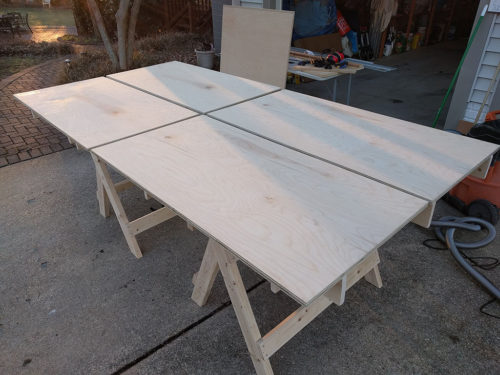I wish I had made this plywood cutting table a long time ago. It makes quick work of breaking down a piece of plywood into more manageable sizes, especially if using a track saw. Perhaps the best feature of the table is that it is portable, allowing it to be assembled in an area with lots of elbow room (such as a driveway) and then stored as a compact bundle in the woodshop when not in use. Most woodworkers that I know – myself included – lack sufficient shop space to have a 4′ x 8′ dedicated cutting table so this portable design makes a big difference.
The cutting table consists of two collapsible saw horses spaced about five feet apart with notches cut into the 2 x 6 top rail to accommodate the grid assembly. The grid is made from 1 x 5 pine (yes, I found 1 x 5 material): three 8-foot pieces and four 4-foot pieces. The 8-foot boards have two 2″ long notches cut into their underside to slip over the saw horse rails. On the top side, four notches are cut halfway down to mate with notches cut into the underside of 4-foot long cross pieces. The whole thing slips together and stays aligned thanks to the notches, leaving a stable and flat work surface. I arranged the spacing of the notches to leave 6″ protruding on the long ends and 4″ protruding on the short ends.
The unsung heroes of the cutting table are the collapsible saw horses which operate in a scissors motion to hold the top rail in place. This involves pulling the two opposing sides towards each other at the base using a ratcheting strap. When tight, you can actually pick up the saw horse by the rail and move into position. Note: these horses are based on a design that the inventor calls the Shop Dog – if you decide to make your own pair, spend the $5 to get the downloadable plans and support the inventor’s time and effort. I refer to my design as the “Shop Pup” because it’s a simplified version of the original – the legs are oriented vertically rather than splayed out (I didn’t feel like messing with compound angles).
With the table assembled, a piece of plywood can be laid on top and the cutting can commence. As you can see, I’m using a Dewalt track saw with attached vacuum hose – the end result is nice clean cuts (no splintering!) and very little dust. Try it, you’ll like it…
Thanks to the grid coverage, the smaller pieces of plywood resulting from the cutting operation remain firmly supported. No worrying about pieces falling off the edge or fancy clamping to hold them in place. I should point out that the cutting grid is sacrificial – it is designed to be cut into and over time will have lots of saw blade kerfs peppering its top surface. However, I anticipate it will be a very long before there are so many kerfs that the boards will be unusable. And when that does happen, it will be a straightforward matter to just create new grid boards.


